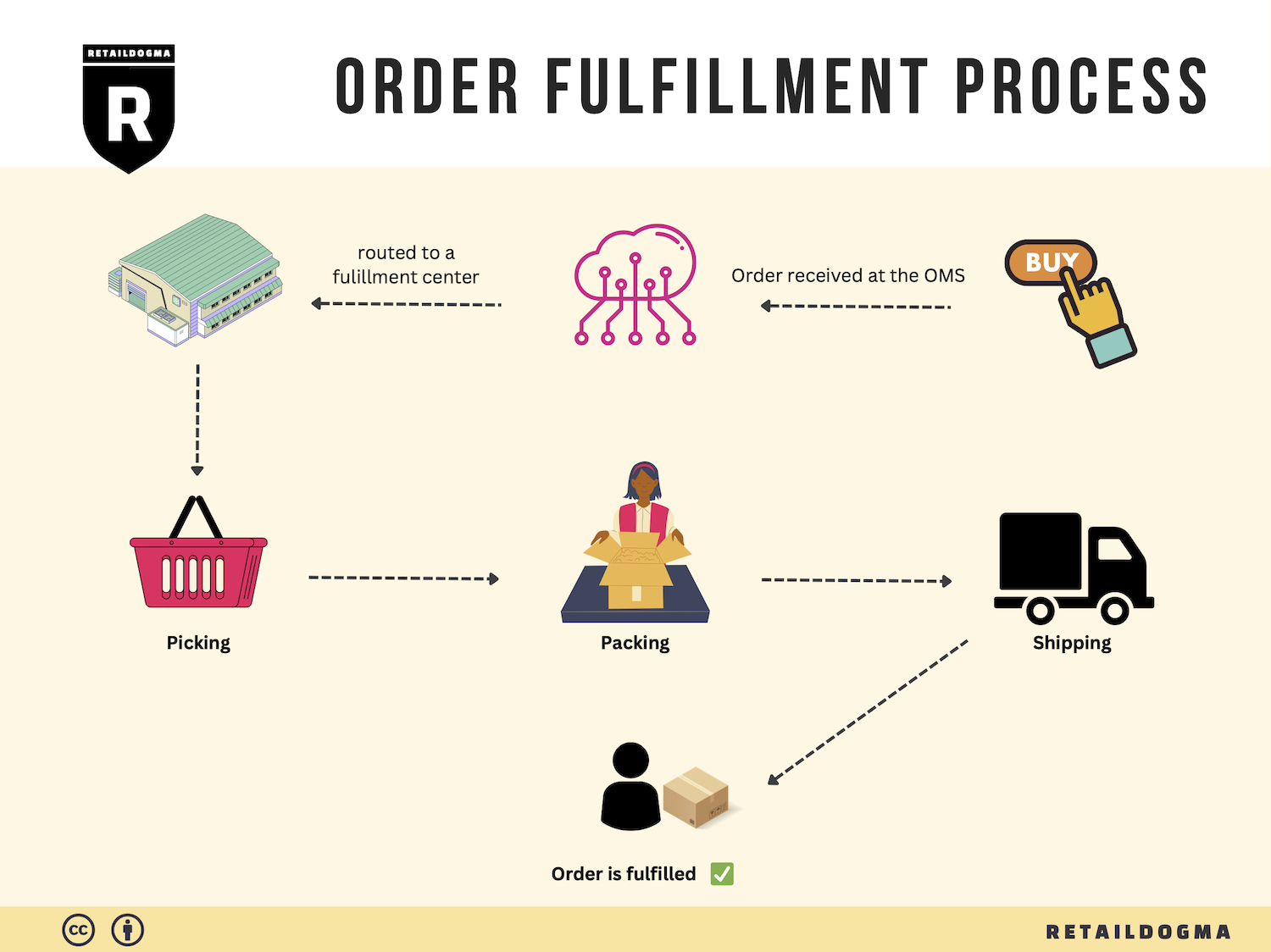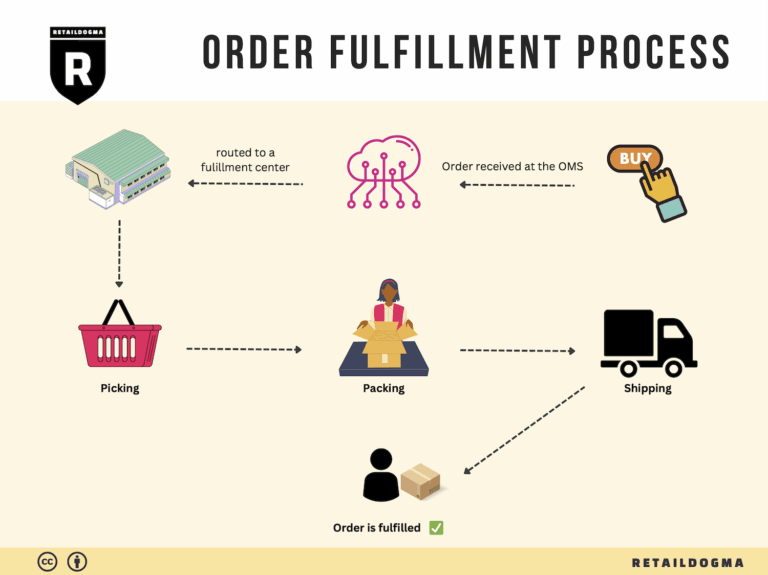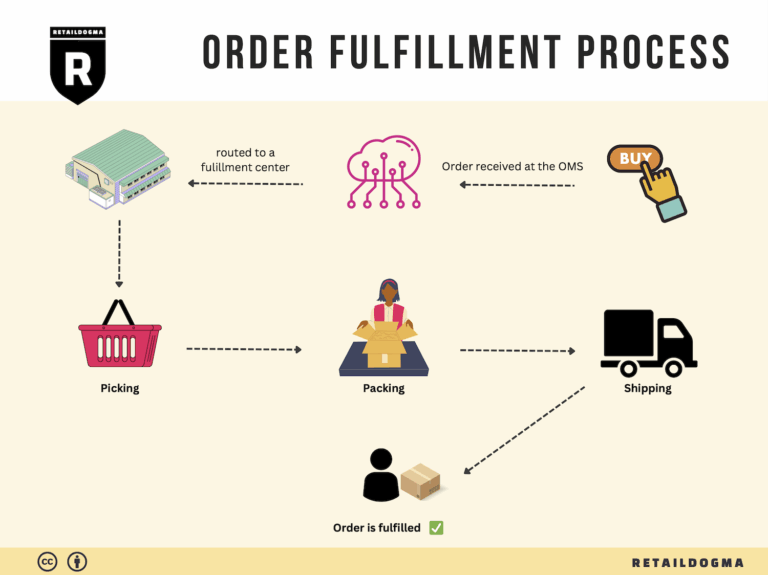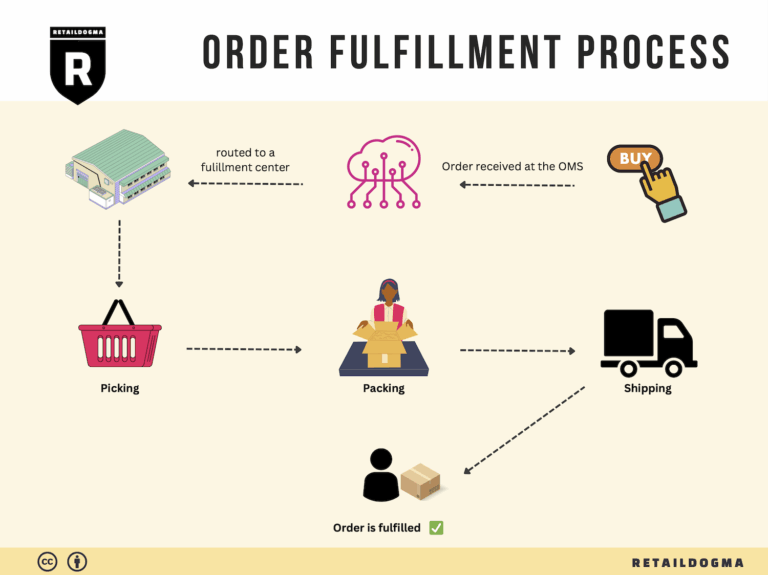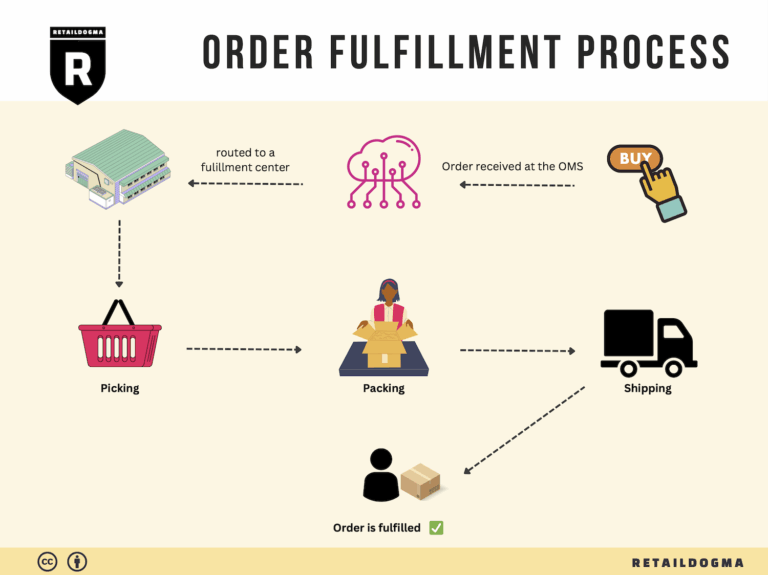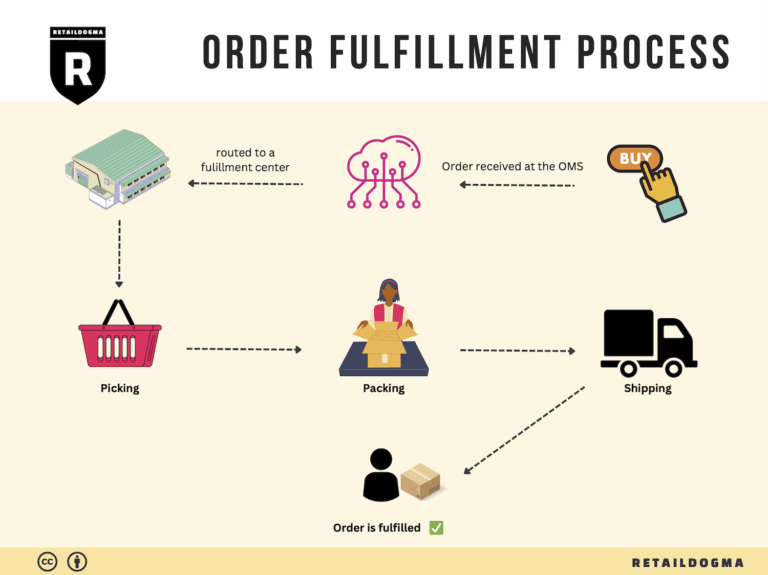How Order Fulfillment Works: A Step-by-Step Guide for Businesses
What is E-commerce Fulfillment? An Introduction for Growing Businesses
Understanding E-commerce Fulfillment: A Key to Scaling Your Business
As a growing e-commerce business owner, you may find yourself grappling with the overwhelming task of packing and shipping orders. This often becomes a bottleneck in your operations, diverting your attention from core business activities like marketing and customer engagement. Fulfillment, at its essence, is the process of getting a product from your warehouse or fulfillment center to your customer’s doorstep. It encompasses everything from inventory management to shipping logistics, and it can significantly impact your customer experience and business growth.
In this guide, we will explore the various fulfillment models available to e-commerce businesses, including Third-Party Logistics (3PL) providers and Fulfilled by Amazon (FBA). Each model has its own set of benefits and considerations, allowing you to choose one that aligns with your business strategy and customer expectations.
We will delve into core fulfillment services such as inventory storage, order processing, packing, and shipping. Understanding these services will enable you to identify what you need from a fulfillment partner, ensuring that your logistics are as efficient as possible.
Additionally, we will provide insights on how to select the right fulfillment partner for your business. Key factors to consider include the partner’s network of distribution centers, technology capabilities, customer service, and scalability. In a competitive market, your choice of fulfillment partner can be a game-changer, influencing your delivery speed and overall customer satisfaction.
Pricing is another critical aspect we will cover. Understanding the cost structures associated with different fulfillment options will empower you to make informed financial decisions. We will break down common pricing models and help you assess the potential return on investment for your logistics operations.
The ultimate goal of this guide is to equip you with the knowledge and tools necessary to make strategic decisions about your e-commerce fulfillment. By understanding the intricacies of the fulfillment process, you can streamline operations, improve customer satisfaction, and ultimately scale your business effectively. Whether you’re just starting out or looking to optimize your existing processes, this guide serves as a valuable resource in navigating the complexities of e-commerce fulfillment.
What You’ll Learn In This Guide
- What is E-commerce Fulfillment? An Introduction for Growing Businesses
- The Order Fulfillment Process: From ‘Buy’ Button to Customer’s Door
- Comparing Fulfillment Models: In-House vs. 3PL vs. Dropshipping
- A Deep Dive into Amazon FBA: Pros, Cons, and Who It’s For
- Core Services Offered by Fulfillment Centers
- How to Choose a Fulfillment Partner: A 6-Point Checklist
- Understanding Fulfillment Pricing: A Breakdown of Common Fees
- Frequently Asked Questions (FAQs) about Fulfillment
- Conclusion: Is Outsourcing Fulfillment the Right Move for Your Business?
- Important Disclaimer
The Order Fulfillment Process: From ‘Buy’ Button to Customer’s Door
1. Receiving Inventory
The first step in the order fulfillment process is receiving inventory at the fulfillment center. This involves accepting shipments of products from suppliers and verifying that the received items match the purchase orders in terms of quantity and quality. Upon arrival, inventory is checked against the purchase order for discrepancies, which is critical for maintaining stock accuracy.
Key terms associated with this step include SKU (Stock Keeping Unit), which is a unique identifier for each product variant. Using SKUs allows for efficient tracking and management of inventory throughout the fulfillment process. Properly managing the receiving process is vital because it ensures that the inventory is correct and ready for storage, reducing errors and delays later in the fulfillment cycle.
2. Warehouse Storage
Once the inventory is received and verified, the next step is warehouse storage. This involves organizing the products in the fulfillment center in a manner that maximizes space and facilitates easy access for order fulfillment. Products are typically placed in designated areas based on their SKUs and demand frequency, following a systematic layout strategy.
The importance of effective warehouse storage cannot be overstated. A well-organized warehouse allows for quicker order processing and reduces the time employees spend searching for products. Key terms here include bin locations, which are specific spots in the warehouse assigned to particular SKUs. By optimizing storage with appropriate bin locations, businesses can enhance efficiency and scalability, ultimately leading to faster order fulfillment and improved customer satisfaction.
3. Order Picking
Order picking is the process where employees or automated systems retrieve the items from storage to fulfill customer orders. This step is crucial because it directly affects the speed and accuracy of order fulfillment. Typically, order picking is guided by pick lists, which are documents or digital notifications detailing the items and quantities needed for each order.
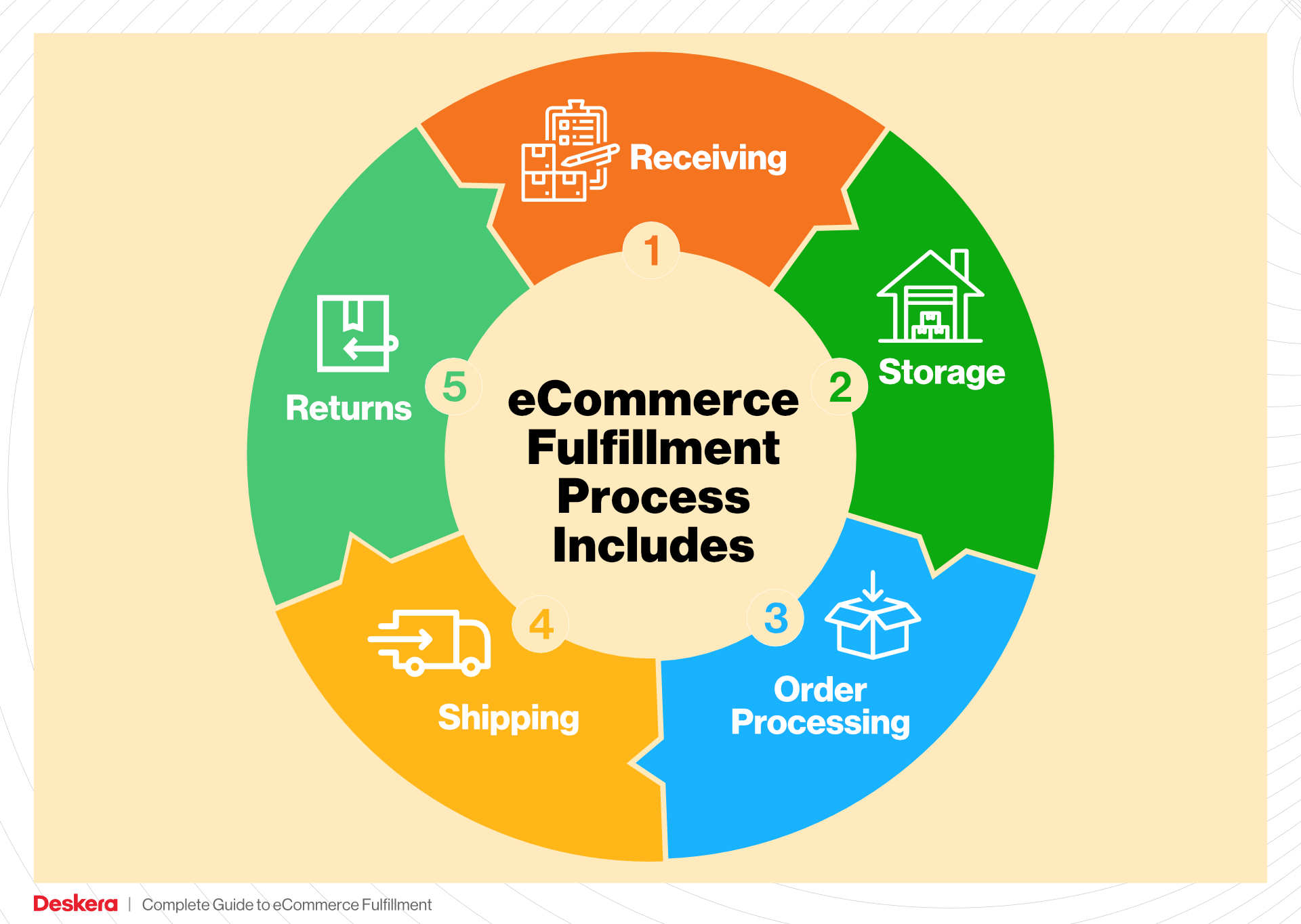
The significance of this step lies in its impact on operational efficiency. Accurate picking ensures that customers receive the correct items in their orders, thereby minimizing returns and enhancing customer satisfaction. Additionally, employing technologies such as barcode scanners and pick-to-light systems can streamline this process, allowing for faster and more accurate order fulfillment. This is especially important for e-commerce businesses that rely on speed to compete in the market.
4. Order Packing
After the items have been picked, the next step is order packing. This involves placing the selected items into packaging that protects them during transit while ensuring they are presented well to the customer. Proper packing is essential not only for protecting the products but also for optimizing shipping costs and ensuring compliance with carrier regulations.
Key terms in this stage include packing slips, which are documents included in the package that detail the items included in the order. Effective packing strategies can lead to reduced shipping costs through the use of appropriately sized boxes and packing materials. Furthermore, attention to packing can enhance the unboxing experience, contributing to customer satisfaction and brand loyalty. A well-packed order not only minimizes damage during shipping but also reflects positively on the seller.
5. Shipping & Delivery
The final step in the order fulfillment process is shipping and delivery. Once packed, the orders are handed over to shipping carriers for delivery to the customer. This step is crucial as it determines how quickly and efficiently the product reaches the customer’s door. Shipping methods may vary based on customer choice, order size, and location, with options ranging from standard to expedited shipping.
Key terms to be aware of include last-mile delivery, which refers to the final leg of the delivery journey from a distribution center to the customer’s location. Efficient last-mile delivery is a significant factor in customer satisfaction and can often be the most expensive part of the shipping process. Businesses should consider partnerships with reliable shipping carriers and leverage technologies such as tracking systems to provide real-time updates to customers. Effective management of the shipping and delivery process ensures that customers receive their orders on time, fostering trust and encouraging repeat business.
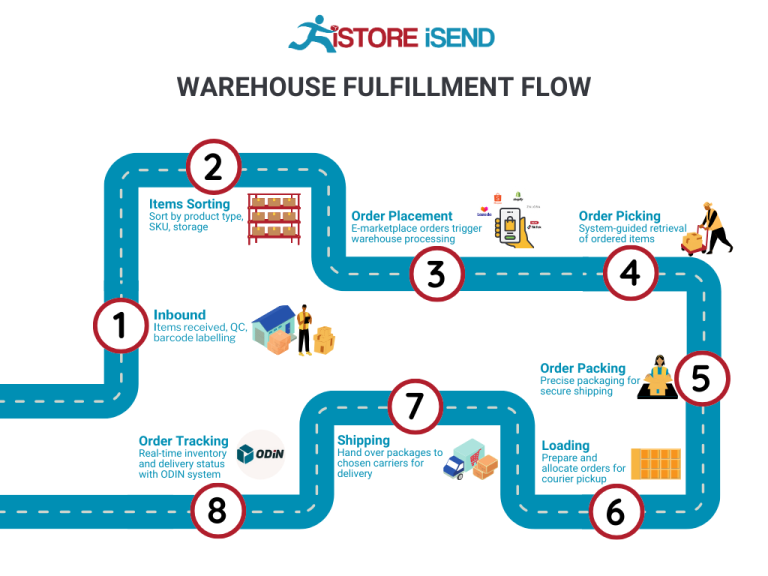
In conclusion, understanding and optimizing each step of the order fulfillment process is critical for e-commerce businesses aiming to scale operations and enhance customer satisfaction. By focusing on efficient inventory management, storage solutions, picking accuracy, careful packing, and reliable shipping, businesses can create a seamless experience from the moment a customer clicks the ‘buy’ button to when the package arrives at their doorstep.
Comparing Fulfillment Models: In-House vs. 3PL vs. Dropshipping
Comparison of Fulfillment Models
| Model | Who Handles Inventory | Best For (Business Stage) | Key Advantage | Key Disadvantage |
|---|---|---|---|---|
| In-House Fulfillment | Business’s own team | Established businesses with stable demand | Full control over inventory and operations | High overhead costs and resource intensive |
| Third-Party Logistics (3PL) | 3PL provider | Growing businesses looking to scale | Cost-effective, scalable solutions | Less control over inventory and shipping |
| Dropshipping | Supplier | Startups and businesses testing markets | Low upfront investment and risk | Lower profit margins and reliance on suppliers |
In-House Fulfillment
In-house fulfillment involves managing the entire inventory and shipping process within your own business. This model is often adopted by established businesses that have a stable demand for their products and sufficient resources. By keeping fulfillment in-house, businesses gain complete control over their inventory, allowing for tailored storage solutions, personalized packaging, and direct oversight of shipping times. This control can significantly enhance the customer experience, as businesses can ensure quality and consistency. However, the key disadvantage of this model is the high overhead costs associated with maintaining a warehouse, staffing, and logistics management. Furthermore, in-house fulfillment requires significant time and resources, which can detract from focusing on core business strategies like marketing and product development. For businesses looking to scale efficiently, this model may not always be sustainable.
Third-Party Logistics (3PL)
Third-party logistics (3PL) providers take over the warehousing, inventory management, and shipping processes for businesses. This model is especially beneficial for growing businesses that need to scale their operations without the burden of managing logistics themselves. 3PL providers offer cost-effective and scalable solutions, allowing businesses to pay for only the services they need as they grow. They typically have advanced technology and infrastructure to optimize shipping processes, which can lead to faster delivery times and reduced shipping costs. However, one of the main drawbacks of using a 3PL is the reduced control over inventory and shipping processes. Businesses rely on the 3PL’s systems and practices, which may not always align with their specific operational needs. Additionally, any errors or delays in the 3PL’s processes can directly impact customer satisfaction, making it essential to choose a reliable partner.
Dropshipping
Dropshipping is a fulfillment model where the retailer does not keep products in stock. Instead, when a business sells a product, it purchases the item from a third-party supplier, who then ships it directly to the customer. This model is particularly appealing for startups and entrepreneurs testing the market, as it requires minimal upfront investment and reduces the financial risk associated with unsold inventory. The primary advantage of dropshipping is that it allows businesses to offer a wide range of products without the costs associated with inventory management or warehousing. However, dropshipping comes with its own set of challenges. Profit margins can be lower compared to in-house fulfillment or 3PL, as suppliers often set the prices. Additionally, businesses relying on dropshipping are dependent on their suppliers for inventory quality and shipping speed, which can affect customer satisfaction. As a result, managing supplier relationships and ensuring quality control becomes crucial in this model.
Conclusion
Choosing the right fulfillment model is a critical decision for any e-commerce business, particularly those looking to scale. Each model—In-House, 3PL, and Dropshipping—has its unique advantages and disadvantages. Established businesses may find in-house fulfillment advantageous for its control and customization, while growing businesses might benefit from the scalability and cost-effectiveness of 3PL. Startups and those testing new markets may lean towards dropshipping for its low-risk approach. Ultimately, the best fulfillment strategy will depend on the specific needs, resources, and growth objectives of the business.
A Deep Dive into Amazon FBA: Pros, Cons, and Who It’s For
Understanding Fulfillment by Amazon (FBA)
Fulfillment by Amazon (FBA) is a service offered by Amazon that allows sellers to store their products in Amazon’s fulfillment centers. In turn, Amazon takes care of storage, packaging, and shipping of these products to customers. This service not only streamlines the logistics for sellers but also enhances their visibility on the platform, thanks to Amazon’s extensive reach and infrastructure.
How FBA Works
-
Setting Up: Sellers create an Amazon seller account and choose to enroll in FBA. They then prepare their products according to Amazon’s guidelines and ship them to Amazon’s designated fulfillment centers.
-
Storage: Once received, the products are stored in Amazon’s warehouses. Sellers can track their inventory levels and manage stock through the Amazon Seller Central dashboard.
-
Order Processing: When a customer places an order, Amazon handles the entire fulfillment process. This includes picking the item from the warehouse, packing it, and shipping it to the customer.
-
Customer Service: Amazon also manages customer service and returns for FBA orders, allowing sellers to focus on other aspects of their business.
-
Multi-Channel Fulfillment: Beyond selling on Amazon, sellers can use FBA to fulfill orders from their own websites or other marketplaces, providing flexibility in how they manage their sales channels.
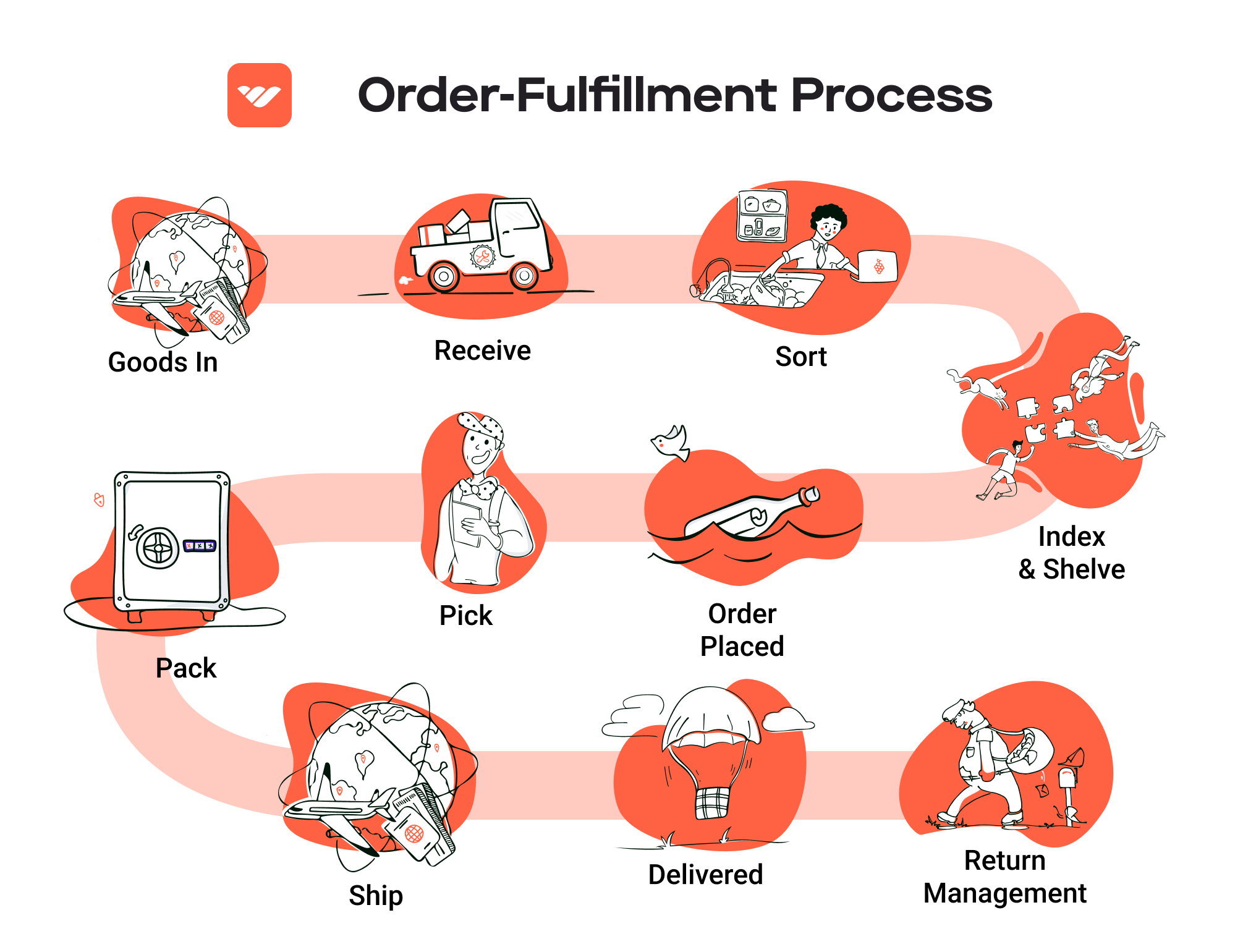
Pros of Using FBA
Prime Eligibility
One of the most significant advantages of FBA is that products become eligible for Amazon Prime. This means sellers can offer their products with the attractive benefit of free two-day shipping, which is a major draw for customers. Prime members are more likely to purchase items that come with this shipping option, increasing the seller’s sales potential.
Customer Trust
Products fulfilled by Amazon carry a level of trust and credibility that is hard to replicate. Customers often prefer buying from FBA sellers because they know that Amazon will handle their orders efficiently. The established reputation of Amazon for reliable shipping and customer service can significantly enhance a seller’s credibility in the marketplace.
Multi-Channel Fulfillment
FBA isn’t limited to sales on Amazon alone. Sellers can use FBA to fulfill orders from their own websites or other e-commerce platforms, allowing them to centralize their inventory management and logistics. This multi-channel capability can lead to increased sales opportunities and a more streamlined operation.
Time and Resource Savings
By outsourcing fulfillment to Amazon, sellers can save substantial time and resources. They no longer need to handle inventory management, packing, or shipping, allowing them to focus on marketing, product development, and scaling their business.
Cons of Using FBA
High Fees
While FBA offers many benefits, it is essential to consider the associated costs. Amazon charges various fees, including storage fees and fulfillment fees, which can eat into profit margins. For sellers with low-margin products, these fees can significantly impact profitability.
Strict Inventory Rules
Amazon has strict inventory management policies that sellers must adhere to. This includes limitations on how much inventory can be stored at any given time and guidelines for product preparation. Failing to comply can result in additional charges or even account suspension.
Commingling Risks
When sellers use FBA, their inventory may be commingled with that of other sellers. This means that if a customer receives a defective or damaged product, it can lead to negative feedback for the seller, even if they were not responsible for the issue. This risk can be particularly concerning for sellers of unique or high-value items.
Limited Control over Fulfillment
While Amazon handles fulfillment, sellers give up some control over the process. This can lead to issues such as inventory inaccuracies or delays in shipping that can negatively affect the seller’s reputation and customer satisfaction.
Who is FBA Best For?
Fulfillment by Amazon is an excellent option for a specific segment of e-commerce sellers:
-
Small to Medium-Sized Businesses: For sellers without the resources to manage their fulfillment process, FBA can provide a scalable solution that allows them to grow without the burden of logistics.
-
Sellers with High Sales Volume: Businesses that expect to sell a high volume of products can benefit from the efficiencies of Amazon’s fulfillment network, especially if their products are eligible for Prime.
-
Brands Seeking Exposure: New or established brands looking to increase their visibility on Amazon will find that FBA can enhance their product listings and attract more customers.
-
Multi-Channel Sellers: Businesses that sell on multiple platforms can use FBA to streamline their fulfillment, making it easier to manage inventory across different channels.
In conclusion, while FBA offers numerous advantages that can help sellers scale their operations and reach more customers, it also comes with challenges that require careful consideration. Understanding the balance of these pros and cons will enable e-commerce business owners to make informed decisions about whether FBA aligns with their growth strategies.
Core Services Offered by Fulfillment Centers
Inventory Management & Warehousing
Inventory management and warehousing are foundational services provided by fulfillment centers, crucial for any e-commerce business looking to scale. Fulfillment centers offer dedicated storage space for products, which allows businesses to maintain optimal inventory levels without the overhead costs associated with owning and operating a warehouse.
The primary benefit of utilizing a fulfillment center for inventory management is the ability to streamline operations. These centers utilize sophisticated inventory management systems that allow for real-time tracking of stock levels, automated reordering, and forecasting based on sales trends. This means businesses can minimize the risk of stockouts or overstock situations, both of which can negatively impact cash flow and customer satisfaction.
Moreover, fulfillment centers typically offer climate-controlled environments for sensitive products, ensuring that items such as electronics or perishable goods are stored under optimal conditions. By outsourcing warehousing to a fulfillment center, e-commerce businesses can focus more on core activities like marketing and product development, leaving the complexities of inventory management to experts.
Pick and Pack Services
Pick and pack services are essential for the efficient processing of customer orders. This service involves selecting (or “picking”) the ordered items from the warehouse shelves and then packaging them (or “packing”) for shipment. Fulfillment centers employ trained staff and advanced technology to ensure accuracy and speed in this process.
The main advantage of pick and pack services is the significant reduction in order processing time. With fulfillment centers strategically located near major shipping routes, businesses can benefit from faster shipping times, which is critical in today’s e-commerce landscape where customers expect quick delivery. Additionally, fulfillment centers often use automated systems to improve accuracy, reducing the chances of errors that can lead to costly returns and customer dissatisfaction.
Furthermore, many fulfillment centers offer customization options for packaging, allowing businesses to enhance their branding and improve the unboxing experience for customers. This not only helps in building brand loyalty but also can lead to increased customer retention rates.
Kitting and Assembly
Kitting and assembly services involve bundling individual products together into a single package or preparing products for sale by assembling them as needed. This service is particularly beneficial for businesses that sell products that require assembly or those that offer kits (e.g., gift baskets, subscription boxes).
The benefit of kitting and assembly services lies in the added convenience they offer to both the business and the customer. For e-commerce businesses, this service reduces the time and labor costs associated with assembling products in-house. Fulfillment centers have the necessary tools, space, and labor force to efficiently carry out these tasks, allowing businesses to scale quickly without the need for additional resources.
For customers, receiving a pre-assembled kit or bundled product enhances the shopping experience by saving them time and effort. This service can also lead to increased sales, as businesses can promote bundled offers that provide better value to customers. By utilizing kitting and assembly services, e-commerce businesses can streamline their operations and enhance their product offerings.
Returns Management (Reverse Logistics)
Returns management, or reverse logistics, is a critical service offered by fulfillment centers that deals with the process of handling returned items. Efficient returns management is essential for maintaining customer satisfaction and loyalty, as it directly impacts the overall customer experience.
The primary benefit of utilizing fulfillment centers for returns management is the ability to streamline the return process. Fulfillment centers can quickly process returns, inspect items, and determine whether they can be restocked, repaired, or need to be discarded. This efficiency not only minimizes losses associated with returned goods but also speeds up the process of getting products back into inventory.
Additionally, a well-managed returns process enhances customer trust. When customers know they can easily return products without hassle, they are more likely to make a purchase. Fulfillment centers often provide businesses with detailed reporting on return reasons, which can help in identifying product issues and improving quality, ultimately leading to a reduction in return rates.
In summary, effective returns management is not just about handling returns; it’s an integral part of a customer-centric approach that can influence future purchasing decisions. By leveraging fulfillment centers for reverse logistics, e-commerce businesses can create a seamless return experience that fosters customer loyalty and satisfaction.
How to Choose a Fulfillment Partner: A 6-Point Checklist
Location & Warehouse Network
Importance:
The geographical location of a fulfillment partner’s warehouses can significantly impact shipping times and costs. A partner with a strategically placed network can ensure faster delivery to your customers, enhancing their experience and potentially increasing sales.
Questions to Ask:
– How many fulfillment centers do you operate, and where are they located?
– Can you provide insights on your shipping times to key regions?
– Do you have warehouses in proximity to my primary customer base?
– What are your capabilities for international shipping, if applicable?
Technology & Integrations
Importance:
A robust technological framework is crucial for seamless order processing and inventory management. Your fulfillment partner should have systems that can integrate with your e-commerce platform, allowing for real-time updates and efficient order tracking.
Questions to Ask:
– What technology do you use for order management and inventory tracking?
– Can your systems integrate with my current e-commerce platform (e.g., Shopify, WooCommerce, etc.)?
– How do you handle inventory updates and order notifications?
– Do you offer any analytics or reporting tools to track performance?
Specializations (e.g., cold storage, oversized items)
Importance:
Depending on your product line, you may require specialized handling capabilities. For example, if you sell perishables, a partner with cold storage facilities is essential. Similarly, if you handle oversized items, ensure the partner has the necessary equipment and space.
Questions to Ask:
– What types of products do you specialize in handling?
– Do you have facilities equipped for temperature-sensitive items?
– How do you manage the storage and shipping of oversized or bulky products?
– Can you accommodate seasonal spikes in demand for specialized items?
Scalability & Capacity
Importance:
As your business grows, your fulfillment needs will change. Your partner should be able to scale operations efficiently to handle increased order volumes without sacrificing service quality. This capability is vital for maintaining customer satisfaction during peak times.
Questions to Ask:
– What is your current capacity for handling orders, and how do you plan to scale?
– Can you accommodate seasonal fluctuations in demand?
– How do you manage logistics during peak sales events, such as Black Friday or holiday seasons?
– What is your process for onboarding new clients and ramping up operations?
Pricing and Contracts
Importance:
Understanding the pricing structure and contractual obligations is essential for maintaining profitability. Look for transparency in pricing and ensure there are no hidden fees that could affect your bottom line.
Questions to Ask:
– What is your pricing model (e.g., per order, per item, monthly fees)?
– Are there additional costs for services such as storage, packaging, or returns processing?
– Can you provide a detailed breakdown of all potential fees?
– What are the terms of the contract, and is there flexibility for renegotiation as my business grows?
Customer Support & Reviews
Importance:
Reliable customer support can make or break your relationship with a fulfillment partner. You need to know that you can reach them quickly when issues arise. Additionally, researching customer reviews can provide insights into the partner’s reputation and service quality.
Questions to Ask:
– What support options do you offer (e.g., phone, email, chat)?
– What is your average response time for support inquiries?
– Can you provide references or case studies from similar businesses?
– How do you handle errors or issues with order fulfillment?
Conclusion
Choosing the right fulfillment partner is a critical decision that can significantly impact your e-commerce business’s success. By using this checklist, you can systematically evaluate potential partners and ensure they align with your operational needs and growth objectives. Remember, investing time in selecting the right partner now can lead to smoother operations, happier customers, and ultimately, a more profitable business.
Understanding Fulfillment Pricing: A Breakdown of Common Fees
Initial Setup Fees
Initial setup fees are often the first costs incurred when partnering with a fulfillment center. These fees typically cover the onboarding process, which includes account creation, system integration, and initial inventory setup. Depending on the fulfillment provider, the initial setup fee can range from a few hundred to several thousand dollars.
Calculation: The fee is usually a one-time charge, but it may vary based on the complexity of the integration required. For example, if your e-commerce platform requires custom API connections or specialized software, expect higher fees. Always ask for a detailed breakdown of what the setup fee includes to avoid unexpected charges.
Receiving Fees
Receiving fees are charged for the process of accepting and inspecting your inventory at the fulfillment center. This fee covers the labor and resources needed to unload, count, and inspect incoming shipments to ensure they match your inventory records.
Calculation: These fees are generally calculated per pallet or per item received. For example, you might pay a fixed fee for every pallet unloaded or a variable fee based on the total number of items. Some fulfillment centers may also have minimum charges, so it’s essential to understand the structure of these fees upfront.
Storage Fees (per pallet/bin)
Storage fees are incurred for the physical space your inventory occupies within the fulfillment center. These fees are typically charged on a monthly basis and can be calculated per pallet or per bin, depending on how the warehouse organizes its inventory.
Calculation: The fee structure can vary widely. Common models include a flat monthly rate per pallet or a tiered system based on the volume of goods stored. For instance, you may pay $15 per pallet per month, but if your inventory exceeds a certain threshold, the rate might drop to $12 per pallet. Additionally, some fulfillment centers charge for cubic space, so knowing how your products are stored is crucial for accurate cost predictions.
Pick & Pack Fees (per item/order)
Pick and pack fees are charged for the process of retrieving items from storage and preparing them for shipment. This fee encompasses the labor involved in picking items, packing them into boxes, and labeling them for shipping.
Calculation: These fees can be calculated per item or per order. For example, you might pay $1.50 for each item picked and packed, or a flat fee of $3.00 per order, regardless of how many items are included. Understanding this fee structure is vital, especially if you have a high volume of small orders, as it can significantly affect your overall fulfillment costs.
Shipping Fees
Shipping fees cover the costs associated with transporting the packaged orders to the customers. These fees can vary based on several factors, including the destination, package weight, and shipping method chosen (e.g., standard, expedited).
Calculation: Shipping fees are typically calculated based on the carrier’s rates and may include additional handling charges imposed by the fulfillment center. Some fulfillment centers offer discounted shipping rates due to their volume, which can be a significant advantage. It’s essential to clarify whether the shipping costs are included in your fulfillment contract or if they are billed separately.
Tips for Getting an Accurate Quote
-
Request Detailed Quotes: When seeking quotes, ask for detailed breakdowns of each fee type. This will help you understand where your costs are coming from and allow for better budget planning.
-
Consider Volume Discounts: If you anticipate high order volumes, inquire about volume discounts. Many fulfillment centers are willing to negotiate rates based on expected shipping and storage volumes.
-
Understand Contract Terms: Ensure you read the fine print. Some fulfillment centers may have hidden fees or clauses that could lead to unexpected charges, such as long-term storage fees for items that remain in the warehouse for extended periods.
-
Evaluate Service Levels: Different fulfillment centers offer various service levels, from basic to premium. Understand what services are included in your quoted rates and whether they align with your business needs.
-
Ask About Flexibility: As your business scales, your logistics needs may change. Inquire whether the fulfillment center can accommodate fluctuations in order volume and if their pricing model allows for scalability without significant cost increases.
By understanding these common fulfillment pricing models and following these tips, you can make informed decisions that align with your business goals and help optimize your logistics costs as you scale.
Frequently Asked Questions (FAQs) about Fulfillment
1. What are Walmart fulfillment centers?
Walmart fulfillment centers are large warehouses designed to store and distribute products for online orders. They serve as critical nodes in Walmart’s logistics network, allowing sellers to ship their products to these centers for efficient order processing, packing, and shipping directly to customers.
2. How many Walmart fulfillment centers are there in the U.S.?
As of now, Walmart operates over 40 fulfillment centers across the United States. These centers are strategically located to ensure efficient shipping and distribution, allowing for quick delivery times to a vast majority of customers.
3. What is the difference between a warehouse and a fulfillment center?
While both warehouses and fulfillment centers store products, their purposes differ significantly. Warehouses primarily focus on storage, whereas fulfillment centers are designed for processing orders. Fulfillment centers handle inventory management, order picking, packing, and shipping, often utilizing advanced technology to streamline these operations.
4. How does Walmart’s fulfillment process work?
Sellers ship their products to a Walmart fulfillment center. Once an order is placed on Walmart.com, the fulfillment center picks the ordered items, packs them, and ships them directly to the customer. This process is designed to maximize efficiency and minimize delivery times, often providing options for free two-day shipping on eligible items.
5. What is a 3PL, and how does it relate to Walmart fulfillment?
A 3PL, or third-party logistics provider, is a company that offers logistics services to businesses, including warehousing, fulfillment, and shipping. Walmart’s fulfillment centers can be considered a form of 3PL, as they handle the logistics of storing and distributing products on behalf of sellers using the Walmart platform.
6. How much do fulfillment services cost at Walmart?
Costs for fulfillment services at Walmart can vary based on factors such as storage fees, order processing fees, and shipping charges. Sellers should consult Walmart’s Seller Center for detailed pricing structures tailored to their specific needs and volume of sales.
7. Can sellers choose which fulfillment center to ship their products to?
Yes, sellers have the flexibility to choose which Walmart fulfillment center to send their inventory to. This choice can be based on proximity to their customer base, which can help reduce shipping costs and improve delivery times.
8. What are the benefits of using Walmart fulfillment centers for e-commerce?
Utilizing Walmart fulfillment centers offers several advantages, including:
– Access to a vast logistics network: Sellers can leverage Walmart’s extensive distribution system to reach more customers.
– Free two-day shipping: Eligible items shipped from these centers qualify for free two-day shipping, enhancing customer satisfaction.
– Operational efficiency: Walmart’s advanced technology and infrastructure streamline the order fulfillment process.
9. How do I find the nearest Walmart fulfillment center?
To locate the nearest Walmart fulfillment center, sellers can refer to Walmart’s official Seller Center or consult logistics partners that specialize in e-commerce. These resources often provide detailed information on fulfillment center locations and their respective service areas.
10. What is the role of automation in Walmart’s fulfillment centers?
Walmart employs advanced automation technologies within its fulfillment centers to enhance efficiency. Automated systems assist with sorting, packing, and inventory management, allowing the centers to process millions of items monthly. This automation not only speeds up the fulfillment process but also helps reduce labor costs and improve accuracy in order handling.
Conclusion: Is Outsourcing Fulfillment the Right Move for Your Business?
Evaluating the Benefits of Outsourcing Fulfillment
Outsourcing your fulfillment process can be a transformative decision for your e-commerce business, offering significant advantages that can drive growth and efficiency. One of the most compelling benefits is the substantial time savings it provides. By leveraging a fulfillment partner, you can delegate the complexities of inventory management, order processing, and shipping logistics, allowing you to focus on strategic initiatives such as marketing, product development, and customer engagement.
Scalability is another critical factor. As your business grows, so do your fulfillment needs. A robust fulfillment service can easily adapt to fluctuating order volumes, seasonal spikes, and expanding product lines, ensuring that your operations remain smooth and efficient without the need for substantial upfront investments in infrastructure.
Moreover, partnering with a fulfillment expert brings a wealth of knowledge and industry best practices to your operations. These professionals understand the nuances of shipping, inventory management, and customer service, and can provide insights that enhance your overall efficiency and effectiveness. This expertise not only mitigates risks associated with fulfillment but can also enhance your customer satisfaction through faster and more reliable shipping options.
Choosing the Right Partner for Growth
However, the success of outsourcing fulfillment hinges on selecting the right partner. It’s vital to consider factors such as their network capabilities, technology integration, and service offerings to ensure alignment with your business goals. A partner that understands your market can significantly enhance your operational performance and customer satisfaction.
Call to Action
As you weigh the option of outsourcing fulfillment, take a moment to audit your current shipping processes. Assess where inefficiencies lie and whether a fulfillment partner could enhance your operational capacity. By evaluating your needs and exploring potential partnerships, you can position your business for sustained growth and success in the competitive e-commerce landscape.
Important Disclaimer
⚠️ Important Disclaimer
The information in this guide is for educational purposes. Fulfillment services, pricing, and platform features change frequently. Always conduct your own due diligence and consult with providers directly before making business decisions.
